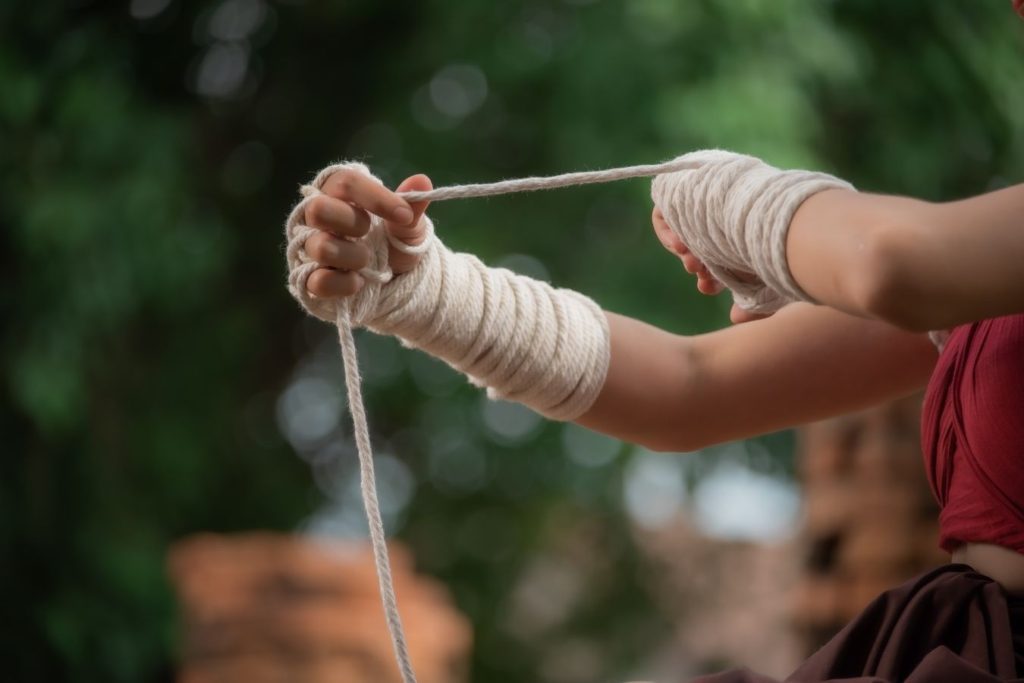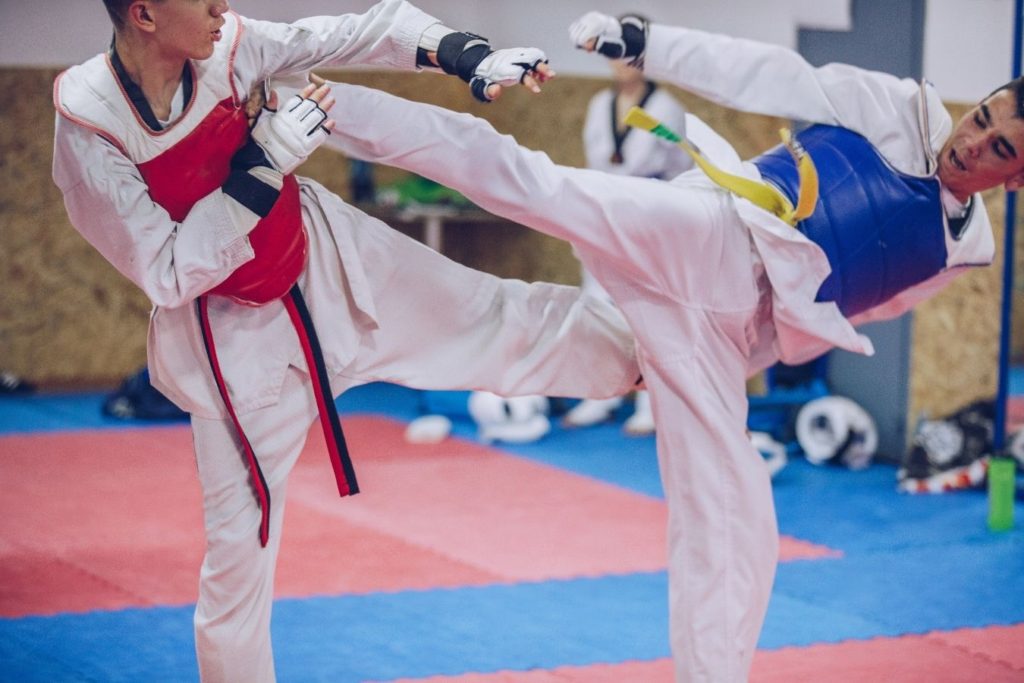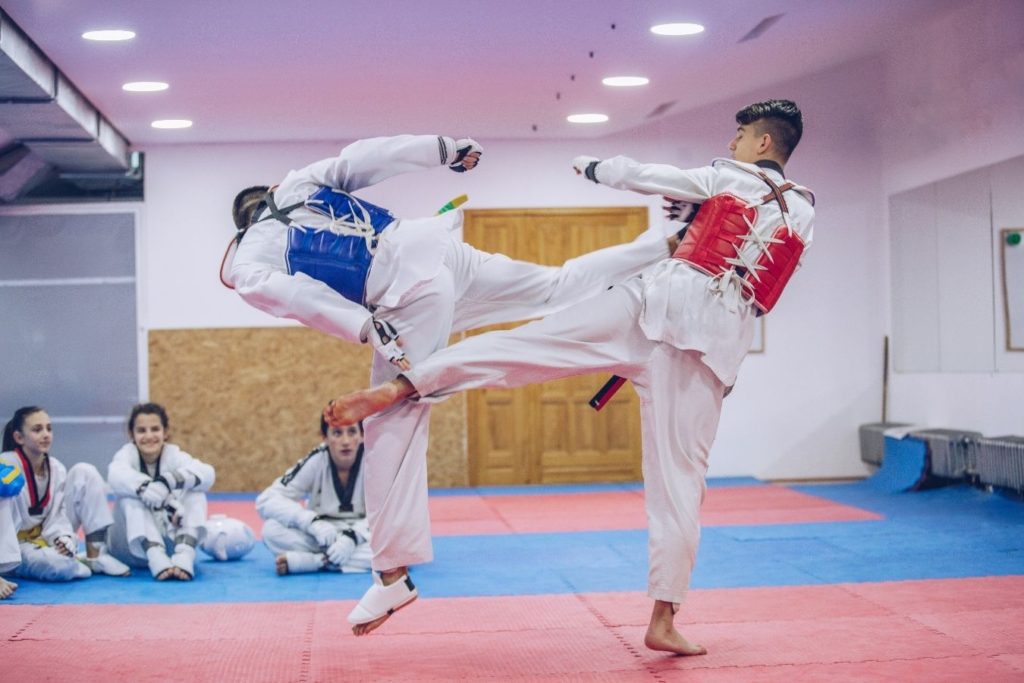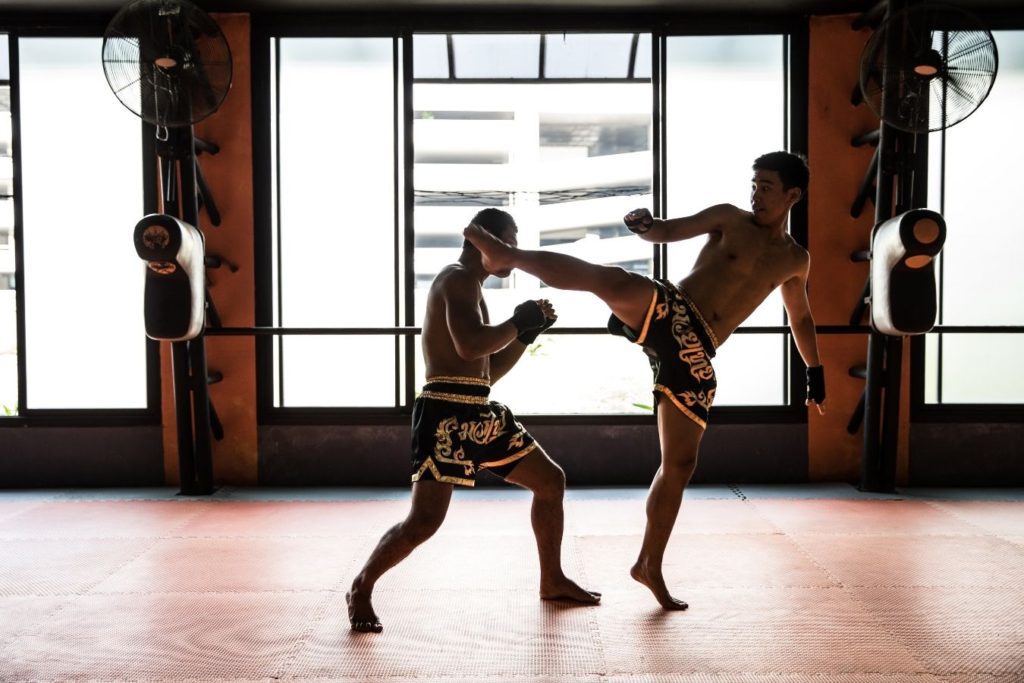Out of the many striking martial arts, Muay Thai and Taekwondo are two of the most popular. Different people pick up martial arts for various reasons, but some aspects are more objective than others. The most straightforward comparison between the two martial arts is a direct clash, and Muay Thai and Taekwondo have had quite a few.
Muay Thai is a martial art that includes punches, kicks, elbows, and knees and is one of the most effective striking styles because of this. Taekwondo is almost exclusively kicking, which makes it visually impressive but not very realistic, which is why, in most cases, Muay Thai fighters win a fight against a taekwondo practitioner.
Even though both styles are striking martial arts, they have more differences than similarities. Learn how they stack against each other in all the important aspects and their direct fighting records.
What Is Muay Thai

Muay Thai, also known as Thai boxing, is Thailand’s national sport and cultural treasure. It is a hand-to-hand fighting style that was first developed several hundred years ago on the battlefields of Siam.
Muay Thai is called “The Art of Eight Limbs” because it uses eight weapons: two feet, two hands, two knees, and two elbows, which makes it more versatile than many other striking styles.
Discover The Little Known Secrets For Unlocking Devastating KO Power!
Heavy hands are built doing these things...
It started in the 16th century, in the time of the Siam Kingdom. During that era, it was a fighting system used on the battlefields by warriors.
Gradually, the style evolved and was used not only for real combat but also for entertainment and as a part of rituals and celebrations.
In the late 19th century, the style of Muay Boran had become very popular, but the version we know today as Muay Thai was codified in the 1920s after the implementation of boxing gloves, rings, timed rounds, and many other aspects borrowed from Western boxing.
Today, Muay Thai is extremely popular as an individual sport and a great striking base for MMA fighters and kickboxers.
What Is Taekwondo

Taekwondo is a Korean martial art and a striking combat sport. The word Taekwondo means “the way of kicking and punching,” and as a style, it emphasizes almost entirely kicking.
Taekwondo can be traced back to the Three Kingdom Era of Korea. The warriors of the Silla Dynasty developed it, called the Hwarang, and was initially called Taekkyon, which means “foot-hand.”
In the 20th century, Korean martial arts masters from different lineages and styles created a single style called Taekwondo, which became the national martial art of Korea.
After this, it started to gain popularity, and finally, the World Taekwondo Federation (WTF) was founded in 1973. In the same year, the first Taekwondo World Championship took place in Seoul, Korea.
Today, Taekwondo is a part of the Olympics, making it a highly prestigious sport and one of the few combat sports represented at the higher stage of amateur sports, alongside wrestling, boxing, and judo.
What Is The Difference Between Muay Thai And Taekwondo?

Rules
As both Muay Thai and Taekwondo are combat sports entirely oriented towards competition, the rules are fundamental and determine how they are trained, which techniques get more attention, and the overall dynamics of the fights.
Taekwondo has more than one version, and the two prominent organizations are WTF (World Taekwondo) and ITF. Although ITF Taekwondo has a lot of practitioners, WTF has the lion’s share of practitioners and schools worldwide so we will use the Olympic rules for the comparison.
Taekwondo WTF rules
- Each fighter attempts to knock out their opponent or score points by landing blows on their opponent’s torso or head. Kicks are allowed to both the torso and head, while punches are only allowed to the body above the waist
- Matches are 3 x 2-minute rounds and are fought on an open mat area
- The match is won by the fighter who knocks their opponent out or who has more points at the end of the three rounds
- In major competitions, electronic vests and helmets are used to register valid strikes, which are scored as follows:
- One point for a basic attack to the opponent’s torso
- Two points for a spinning kick to the opponent’s torso
- Three points for a kick to the head
- Punches to the head are forbidden
Muay Thai Rules
- Each fighter attempts to knock out the opponent with a legal strike. If there is no knockout at the end of the fight, the judges declare the winner.
- Matches are 5×3 minute rounds and are fought in a boxing ring
- Punches, kicks, elbows, and knees are allowed
- Clinching and some throws from the clinch are allowed
- Judges score each round on a 10-point system based on different criteria like damage dealt and aggression, but the final decision is not determined by summing of points like in boxing
Techniques
Muay Thai is known for many things, including devastating elbows, crushing roundhouse kicks, piercing knees, and an elaborate clinch game. Punching is part of Muay Thai, but it’s arguably the least developed and used by most fighters.
The kicking style of Muay Thai is quite characteristic and reflects the goal of delivering the most powerful and damaging kick possible, not necessarily the fastest. This is why Thai-style roundhouse kicks are thrown with full hip rotation and should land with the shin.
The other signature kick is the front kick called a teep. Whereas in most other styles, the front kick is thrown to damage the midsection, in Muay Thai, both the lead and rear teep are more of pushing and range manipulation tools.
Clinching is also emphasized in Thai martial art; some fighters specialize in close-range fighting by utilizing elbows, knees, foot trips, and throws.
Taekwondo is all about the kicks. Since face punching is banned (in ITF, it is allowed, but not full contact) and body punching is scored poorly, taekwondo matches can be compared to fencing with feet.
Because each kick is scored individually, taekwondo kicks are lightning-fast and snappy and land with the foot for maximum speed and range.
Then there are some wild flying and spinning kicks, which are impressive as an athletic feat and devastating if one manages to land them.
Equipment
Muay Thai competitors use only distinct Muay Thai style shorts as their fight apparel, but for training, there are a few pieces of gear you will need, and the list includes:
- Muay Thai boxing gloves
- Muay Thai shin guards
- Mouthguard
- Groin cup
- Muay Thai shorts
- Ankle supports
The taekwondo uniform, called a dobok, is a type of kimono consisting of a jacket, trousers, and colored belt. The full set of protective gear for competitions under WT rules includes:
- Head guard
- Chest protector (called hogu)
- Groin guard
- Forearm guards
- Hand protectors
- Shin guards
- Mouth guard
Competitive Landscape
Both Muay Thai and Taekwondo thrive because of the vast competitive landscape. Muay Thai is the national sport of Thailand and is held in the highest regard there, with many dedicated stadiums holding frequent events.
Worldwide, professional promotions do events in different countries, but sports like boxing, MMA, or even kickboxing are more widespread. Muay Thai also has an amateur version, which is more popular in some countries than others.
Taekwondo does not have a professional scene, but as a part of the Olympics, it is very popular with millions of practitioners and competitors at all levels.
Many countries have national federations that hold domestic events and participate in continental competitions and World Championships. The highest honor in Taekwondo is reaching the Olympics and winning a medal.
Styles/Forms
When it comes to Muay Thai, there are seven known fighting styles. Each of these is detailed below.
- Muay Bouk: These fighters use a variety of ranges and techniques and are also mainly aggressive fighters.
- Muay Mat: These fighters are the ones that favor punching and low kicks and mostly work from medium and close ranges.
- Muay Tae: These are aggressive fighters who like to use kicks and mostly work from long to medium ranges.
- Muay Khao: These fighters are known to use their knees from medium to clinch range.
- Muay Sok: These fighters primarily like to elbow their opponents from close to clinch range.
- Muay Plam: These are mainly aggressive clinch range fighters.
- Muay Fimeu: These are technical fighters who use elusive, counter, and tricky modes at long to medium range.
And in the case of Taekwondo, there are three main types of fighting, which are:
- World Taekwondo Federation (WTF): This is known as the Olympic style and the most common one. It emphasizes using different types of kicks, with less emphasis on punches.
- International Taekwondo Federation (ITF): This is a traditional style of taekwondo, which puts more emphasis on punching or using your fists than kicking or using your legs.
- American Taekwondo Association (ATA): ATA is the most popular style of taekwondo in America. It is a hybrid of the WTF and ITF styles but places emphasis on using the legs. It also allows the use of weapons, such as nunchucks or bow staff.
Muay Thai vs Taekwondo For MMA
Undoubtedly, Muay Thai is better for MMA than Taekwondo. Being a full-contact striking art allowing strikes with all limbs, Muay Thai gives its practitioners more to work with under the liberal MMA rules.
Then, the clinch game also has a lot of cross-over value into MMA, where grappling is an integral part of the sport.
Since the first days of modern mixed martial arts in the 1990s, Muay Thai has been one of the top choices for striking base. While MMA striking is now a distinct style in itself, the Thai martial art remains a great fit.
Taekwondo has some value in terms of athleticism, speed, and ability, but as a whole, it is not very suitable for MMA.
The sports ruleset is severely limited, and the lack of head punches and low kicks creates an entertaining but unrealistic match style.
If you implement the same game plan into MMA, the result will likely be a quick and brutal beatdown of the taekwondo practitioner.
With that said, there are more than a few fighters, like Anthony Pettis, Michael Venom Page, and Yair Rodriguez, who have managed to make taekwondo work in MMA, and the results are truly spectacular and impressive to watch.
Muay Thai vs. Taekwondo For Self-Defense

Similarly to the previous arguments, Muay Thai is much better for self-defense than Taekwondo.
A Muay Thai fighter has long-range weapons with his kicks, mid-range punches, knees, and elbows for close range. Standing grappling is also a strong domain because of the well-developed clinch game in Muay Thai.
On the other hand, Taekwondo can work in a real fight, but the situations in which it can be used safely are too few.
A taekwondo fighter needs range and space to operate, which is often lacking in real-life scenarios.
Taekwondo kicks are undoubtedly strong and dangerous, but throwing high kicks is dangerous, let alone doing flashy stuff like tornado kicks.
Then there is the absence of meaningful punches and any form of grappling, and you can see why Taekwondo is inferior to Muay Thai regarding self-defense capabilities.
Who Would Win a Fight Between Muay Thai and Taekwondo?
Muay Thai easily beats Taekwondo in one-on-one fights. Don’t believe me? Luckily, we have heaps of evidence to back this claim up.
There is an outstanding video with footage from different tournaments and challenge matches. Each point is well articulated is video proof, and everything is in context:
But I will briefly summarize the video if you don’t want to watch 40 minutes of taekwondo guys getting beaten, even though I advise you to watch the entire film.
The simple reason why Taekwondo usually loses against Muay Thai, and kickboxing is that taekwondo competitions are very limited by the rules and produce unrealistic fights.
Because of the body protector, Taekwondo practitioners are not used to receiving punches to the head and kicks to the legs and even the body. Taekwondo fighters can’t react adequately when an opponent does any of these things.
Furthermore, taekwondo kicks are devastating and spectacular, but flashy moves leave you open for counterattacks and are easily punishable.
Muay Thai vs Taekwondo: Which Is Better?
Even though the scales in the comparison are heavily tipped towards Muay Thai, there cannot be a better martial art overall, as each has flaws and drawbacks.
For me, a good martial art has to have the martial element down, and Muay Thai is much more realistic, effective, and overall better at fighting.
Nak Muay are vicious and deadly warriors, but the sport is also practiced by many regular folks who use training to get in shape and develop some basic fighting skills. There aren’t significant physical requirements to train, and many people can enjoy it.
The downside of Muay Thai is that it’s quite hard on the body. Body conditioning is essential, and sparring is one of the core elements of the sport, so you are bound to get a lot of bumps and bruises even as a weekend warrior with no intention of competing.
Taekwondo is an inferior martial art in terms of practicality, but it has a lot of other benefits. It also builds excellent physical and mental qualities and offers a great path to becoming an Olympic athlete—one of the highest honors for anyone in sports.
The Korean art also has a solid traditional element, and there are forms of training and a strict hierarchy, which are especially valuable for kids.
Taekwondo is one of the best martial arts for kids, and it can build great physical and mental foundations in them.
Ultimately, the better of the two is the one you feel more drawn to, which will fit your goals. This author’s choice is easy: Muay Thai every day.

